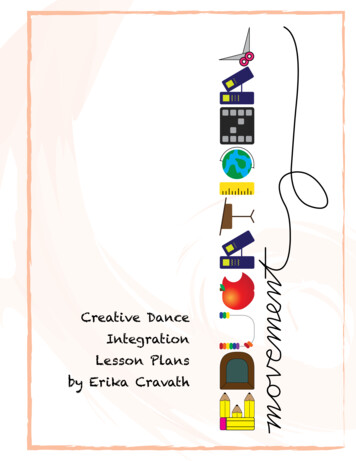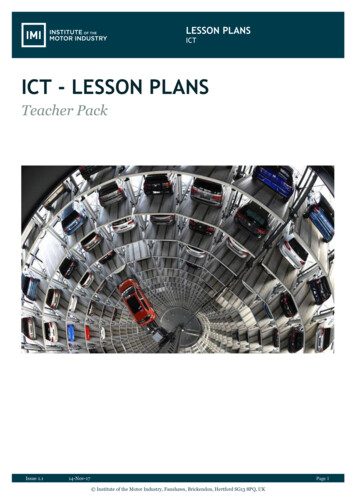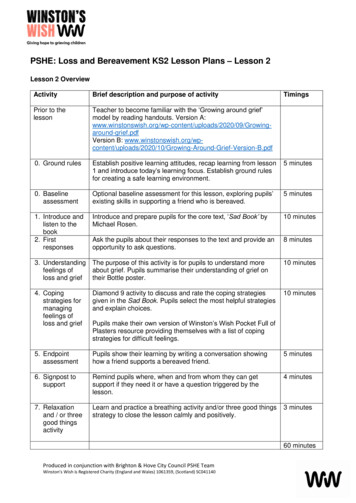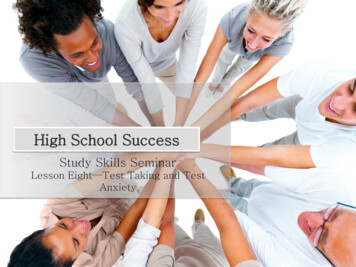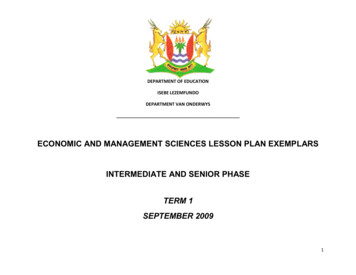
Transcription
DEPARTMENT OF EDUCATIONISEBE LEZEMFUNDODEPARTMENT VAN ONDERWYSECONOMIC AND MANAGEMENT SCIENCES LESSON PLAN EXEMPLARSINTERMEDIATE AND SENIOR PHASETERM 1SEPTEMBER 20091
The Eastern Cape Department of Education in collaboration with the District Curriculum Personnel developed thisdocument in order to support teachers in their implementation of EMS in the classroom. It is envisaged that these LessonPlans will improve the quality of teaching and learning and therefore contribute to improved Learner performance.The document contains exemplars of lesson plans with activities on each cluster of assessment standard in all learningoutcomes. It is prepared with the intention to give necessary guidance for lesson planning for Term 1 in accordance withthe Provincial Work ScheduleWhen using this document teachers are encouraged to use a variety of textbooks and other available resource material.Teachers are encouraged to adapt these activities to suit their own context. It should be remembered that the documentshould be perceived as a guideline document and is not to be utilized exclusively for teaching, learning and assessment.Teachers are therefore encouraged to extend the activities and move beyond these exemplars.This document must also be read and used in conjunction with National Curriculum Statements, National AssessmentGuidelines, Provincial Assessment Guidelines, and Provincial Resource Material for EMS.2
INTERMEDIATEPHASE3
TABLE OF CONTENTSCONTENTGrade 4 OverviewGrade 4 Lesson Plan ExemplarsGrade 5 OverviewGrade 5 Lesson Plan ExemplarsGrade 6 OverviewGrade 6 Lesson Plan ExemplarsGrade 7 OverviewGrade 7 Lesson Plan ExemplarsGrade 8 OverviewGrade 8 Lesson Plan ExemplarsGrade 9 OverviewGrade 9 Lesson Plan ExemplarsPAGES5–67 – 1920 – 2122 – 4243 – 4647 – 6162 – 6566 – 8586 – 8990 – 125126 – 130131 - 1574
OVERVIEW GRADE 4TERM 1Learning Outcomes andAssessment StandardsLO 1: ECONOMIC CYCLETERM 2Learning Outcomes andAssessment StandardsLO 4: ENTREPRENEURKNOWLEDGE AND SKILLSCLUSTER 1AS 1: Describes the roles of membersof households as consumers andproducers in need satisfaction processCLUSTER 1AS 1: Identifies differentcharacteristics (abilities and talents)of entrepreneursAS 2: Explains the effects on thecommunity of both responsible andirresponsible use of resources andservicesAS 2: Explains how entrepreneurscombine labour (work), capital(money, machinery, tools) and naturalresources (raw materials) to gainprofitCLUSTER 2AS 3: Describes the role of formal aninformal businesses in societyAS 4: Explain the concept of tax insimple languageCLUSTER 3LO 2: SUSTAINABLE GROWTHAND DEVELOPMENTAs 1: Identifies the difference instandards of living of highlydeveloped and subsistence economiesAS 4: Differentiates between theentrepreneurial actions of buying,selling and producingCLUSTER 2LO 3: MANGAGERIAL,CONSUMER AND FINANCIALKNOWLEDGE AND SKILLSAS3: Identifies different sources ofpersonal income and plans saving andspending by drawing up a basicpersonal budgetTERM 3Learning Outcomes andAssessment StandardsLO 3: MANAGERIAL,CONSUMER AND FINANCIALKNOWLEDGE AND SKILLSTERM 4Learning Outcomes andAssessment StandardsLO 2: SUSTAINABLE GROWTHAND DEVELOPMENTCLUSTER 1CLUSTER 1AS 1: Participates in the managementof classroom projectAS 2: Distinguishes three differenttypes of local businesses: Trading (e.g. spaza shops, fleamarkets, car boot sales and shops Manufacturing (e.g. brickyard,bakery, factory) Servicing (e.g. taxi, hairdressers,hotel and bed and breakfastCLUSTER 2LO 4: ENTREPRENEURIALKNOWLEDGE AND SKILLSAS 2: Describes the economic andsocial impact of the discovery ofmineral in South Africa (e.g. jobcreation, exploitation of cheap labour,migratory labour, health and safetyhazardsCLUSTER 2LO 2: SUSTAINABLEDEVELOPMENT AND GROWTHAS 3: Identifies the localcommunity’s efforts in fightingpoverty (e.g. RDP, urban renewal andrural developmentAS 5(4): Participates in a fair ormarket day at school or in thecommunity to practice and applyentrepreneurial knowledge and skillsAS4: Investigates use and purpose ofa savings account5
CONTENTLOCAL COMMUNITYAS 1:Concepts: Basic needs Need satisfaction process Households Producers ConsumersAS 2:Concepts: Resources Services Renewable and nonrenewable resourcesResponsible and irresponsible use ofresources (e.g correct and incorrectuse of water, public money; pollutionof dams, wastage, recycling and reuseAS 3:Concepts: Formal business Informal business (e.g. spazashops)AS 4:Concepts: Tax Taxpayer GovernmentLO 2 AS 1:Concepts: Standard of living Highly developed economiesSubsistence economiesCONTENTENTREPRENEURSHIPAS 1:Concepts; EntrepreneurCharacteristics (abilities and talents)AS2:Concepts: Factors of production Labour Land Capital Natural resourcesAS 4:Concepts: Buying & selling Producing Income & expenses Cost & selling priceAS 3:Concepts: Personal income Sources of income Spending and saving Expenditure Basic personal budgetAS 4:Concepts: Savings accounts Uses and purpose of savingsaccountCONTENTAS 1:Concepts: Planning Organizing Leading Controlling ProjectAS 2:Concepts: Trading businessese.g.: Spaza shops Flea markets Car boot sales Shops Manufacturing businesses e.g. Brickyard, bakery andfactoryServicing businesses e.g. Taxi, hairdresser. Hoteland bed and breakfastCONTENTAS 2:Concepts: Minerals Migratory Labour Cheap labour Poverty Economic impact ondiscovery of mineralsin South AfricaAS 3:Concepts: Poverty Poverty eradicationresources RDP Urban renewal Rural developmentprojectsAS 5:Concepts: Planning Organizing Leading Controlling Target group Product / service Marketing strategy Pricing Cost and selling price Participates in a fair or market day6
GRADE 4 LESSON PLAN 1Learning Area: Economic and Management SciencesDate Completed:SKILLSKNOWLEDGEConcepts: Basic needs Group workNeed satisfaction Critical thinkingHouseholds DiscussionProducers ReadingConsumers ListeningBasic concepts: InvestigationGrade: 4Duration: 5 weeks (10 Hours)VALUES Respect forothers’ opinions. Tolerance. SharingknowledgeResources ( natural and man-made)ServicesCommunityResponsible and irresponsible use of resources.LO 1: Economic CycleAS1: Describes the roles of members of households as consumers and producers in the need satisfaction process.AS2: Explains the effects on the community of both responsible and irresponsible use of resources and services.7
ACTIVITY 1( a )The teacher divides learners into groups and gives each group a shopping pamphlet from SPAR, Shoprite, andPick ‘n Pay etc. Each group will use the table below to list 5 items that are needs and 5 items that are wants.Things you must have to surviveThings you would like to have but are not essentialfor survival1.2.3.4.5.The teacher will ask learners to swop books and mark the activity. The teacher explains by stating to the class thatthings needed for survival are called needs and things we would like to have but are not needed for survival arecalled wants. When we buy these products be it needs or wants we are satisfying our needs. Needs and wantsdiffer from one person to another.Assessment: Form: Class work , Form: Memo Method: PeerACTIVITY 1(b)The teacher will write the following concepts on the board and asks learners to use dictionaries to look up themeanings of the words: Consumer, Producer, and Household. The teacher then gives the learners the answersand does consolidation.Assessment: Class work Form: Memo Method: Educator8
ACTIVITY 1 ( c )The teacher gives the learners the following homework assignment:Informal Investigation; Learners are to go home and ask their parents the following questions :(i)List the members of your household.(ii)What are the needs of your household?(iii)What are the items that are consumed by your household?(iv)What role does each member of your household play?(v)How does your household receive income to satisfy its needs?Assessment: Form: Class work Informal Investigation Form: Memo Rubric Method: EducatorActivity 1 ( d )The learners return the following day and the teacher assists them to write a report on their findings.Once the reports have been written, the teacher asks the learners to present their findings to the class.Assessment: Form : Formal Presentation , Tool: Rubric Method : EducatorActivity 1 ( e )The teacher explains that in some households, parents are owners of businesses; they either sell or produce goodsor services. All the members of the households are consumers. He further explains that when a producer (a farmer)sells his products (milk) or service to consumers, he earns money. He then uses the money to buy more goods9
(more cows, feed and medication) to sell. He is also called a consumer. This keeps his business going. Moneygoes in a cycle between producers and consumers. We call this a need satisfaction process or a two sectorcircular flow.The teacher gives the learners a picture of household members Annexure A to study and then answer thefollowing questionsa) Mrs Bam grows vegetables. She is a b) Sam buys sweets and cool drink. He is a .c) Mr Bam and the family buy food from the supermarket. They are .d) Sinazo makes popcorn. She is a e) Charles wears the clothes her grandmother makes. Charles’s grandmother is a The teacher instructs the learners to swop their books for marking and then do corrections.Activity 1 ( f )The teacher gives the learners the following homework :Complete the following sentencesa) I am a consumer. I eat food. This is a needb)My is a producer. He or she makes or grows These are c)My .is a consumer. He or she buys or uses .These are .Learners give individual reports to their group members. The teacher goes around listening to the reports andprovides input where necessary.10
ACTIVITY 2( a )The teacher asks the learners to work in groups and look up the meanings of the following concepts: Resources Services Community Responsible IrresponsibleThe teacher will then provide learners with the answers and clarify any problems that the learners might have.ACTIVITY 2 ( B )The teacher will then ask learners to work in groups and brainstorm examples of the above conceptsExpected answers:Resources – land to build houses, land for sport fields, electricity for heat and lights as well as clean water, etc.Services – sewerage, removal of garbage, police (safety) , health care, etc.The teacher goes on to explain that these resources and services can be used responsibly or irresponsiblyACTIVITY 2(C)The teacher reads the newspaper article on Residents Roll up sleeves Annexure A )to the class.Thereafter, the following questions are asked relating to the article.11
(i)How were resources irresponsibly used before the community members decided to take action?Answer: litter is strewn and refuse is not removed in informal settlements. As a result the resource, which isthe land, is irresponsibly utilized.(ii)What effect will the irresponsible use of the resource have on the community in which these residents live?Answer: litter and pollution causes health problems and can lead to the spread of diseases. People living inareas that are not clean do not take pride in their area and the problem could just worsen.(iii)What was done by these community members to encourage the responsible use of resources?Answer: 10 community members were trained on health, hygiene and leadership. Residents were advisedon how to keep the area they live in clean. Illegal dumping was going to be stopped.(iv)What effect did the previous actions of littering have on the community?Answers: Littering exposed children to all kinds of diseasesACTIVITY 2D(I)Teacher gives the learners an investigative task of identifying resources and services that are used irresponsibly intheir communities. Copy and complete the tableResourceHow it is usedWhat the result will be12
A13
ANNEXURE BGrade 4Formal Tasks: AssignmentTotal: 20 MarksLO 1: Economic CycleAS2: Explains the effects on the community of both responsible and irresponsible use of resources and services.Instructions to learners: Learners are to go into their communities and observe the use of resources andservices in the areas they live.1.What resources are being used by your community in an irresponsible manner?2.Explain how these resources and services are being used irresponsibly.3.What negative effects do the irresponsible use of these resources and services have on the community you livein.4.Give advice to your community members on how they can responsibly use these resources and services.5.Explain to them what positive effects the responsible use of resources will have on life in your community.Present all your information in the form of a report that could be presented to the leaders in your community.14
Rubric for AssignmentCriteria43211. Gathering of dataExcellent gathering of all Most data required hasdatabeen gatheredFair amount of data wasnot gathered.Excessive amount ofdata is missing.2. Written presentationof workExcellent presentation ,very neat and colourful,use of pictures ordrawings to supportdata gatheredGood presentation,relatively neat and tidyno picturesSatisfactorypresentation not veryneat, no colourPoor presentation, veryuntidy.3. Relevance of dataVery relevant , to thepoint all informationneeded is presented inreportRelevant and to thepointSatisfactory but someinformation is notrelevantInformation gathered isirrelevant4. Report writingExcellent report – verydetailedGood report- fairamount of detailSatisfactory report-Poor report – totallyunsatisfactory.Handed in on/ beforedue dateHanded in 1 day lateHanded in 2 days late5. Date of submissionNot a large amount ofdetailHanded in 3- 5 days late.Assessment form: Formal Assignment Form: Rubric Method: Educator15
GRADE 4 LESSON PLAN 2Learning Area: Economic and Management SciencesGrade: 4Date Completed:Duration: 3 weeks (6 Hours)VALUESSKILLSKNOWLEDGE. Concepts: Group work Formal business Respect for others’ Informal business (e.g. spaza Critical thinkingopinions.shops) Discussionthe role of formal and informal Tolerance.businesses in society. Reading Sharing knowledgeConcepts: Listening Tax Taxpayer Investigation GovernmentLO 1: Economic CycleAS 3: Describe the role of formal and informal businesses in society.AS 4: Explain the concept of tax in simple language.16
ACTIVITY 1( a )The teacher will start the lesson by playing a game called the HOT Potato. A tennis ball is used in this activity. The ball isthrown from one learner to another. The learner in possession of the ball has to name any business that they in their areathat they know of. As learners name the businesses the teacher will write the names of the businesses on board.Learners then take their seats and the educator explains that these businesses differ from each other in many ways.Some differences: Some owners operate their businesses from home. Some people sell their goods on street cornersand some are vendors and hawkers. They do not pay tax and have no fixed working hours or earn a fixed income. We callthese informal businesses.Some businesses are operated from formal premises, offices or factories. They pay tax and have fixed working hours.These businesses are called formal businesses.i) The teacher then asks learners to classify the businesses that are listed on the board as formal and informal businesses.ii) Learners will be shown two pictures, Annexure A to study and then compare the businesses using the followingworksheet:CRITERIAFORMAL BUSINESSINFORMAL BUSINESSBig/smallCustomersMany/fewer goodsMany/fewer workersself/over the counter service17
The teacher instructs the learners to swap their books for marking and then do corrections.Activity 1(b)The teacher will give the learners the following homework task:Learners are to ask their parents, neighbours and families the following questions:a) What they feel the role of businesses is in the community.b) Why do they think businesses, whether formal or informal are importantc) What value do they have to the community and society.Activity 1 (c)During the next lesson they teacher will get the responses form the learners and do consolidation :ConsolidationThe role of Formal and Informal business in the society: Provider of employment Making goods and services available to community. Providing income to households when entrepreneurs start businesses.Activity2(a)As prior knowledge, the teacher asks the learners where their parents as household members get their money from(Responses will differ). We call the money they earn incomeS/he then tells them that there is a portion of the money that is deducted from their parents’ every month. People who18
earn no or little money are not charged the money.The teacher asks the learners where the money goes to. S/he explains that the money goes to the government so that inreturn they provide services. Like water, electricity, housing, schools etc.Learners are given a picture to study, Annexure B and then answer the questions that follow.The teacher asks the learners to answer the questions orally and then consolidates the activity by telling them that .we call the money paid by people living in the country to the government so that they provide them with services TAX. The moneypeople pay to the government is called INCOME TAXRESOURCESDictionary, Pictures, Chalkboard, Worksheets, Textbook,EXPANDED OPPORTUNITIESTEACHERS REFLECTION:Were the outcomes met?Did learners perform well in the informal assessment tasks?Did the activities strengthen the learners’ competencies in skills, knowledge and values?How can I improve my teaching strategies?BARRIERS TO LEARNING19
OVERVIEW GRADE 5TERM 1TERM 2Learning Outcomes andAssessment StandardsLO 1: THE ECONOMIC CYCLELearning Outcomes andAssessment StandardsLO 4 : ENTREPRENEURIALKNOWLEDGE AND SKILLSCLUSTER 1AS 3: Identifies enterprises and events inown community (e.g. sporting events,craft work) where specific goods andservices are being sold to satisfyconsumer’s needs and generate profitLearning Outcomes andAssessment StandardsLO3: MANAGERIAL, CONSUMERAND FINANCIAL KNOWLEDGEAND SKILLSCLUSTER 1AS 1: Participates and demonstratessome management and leadership rolesin the classroom and home in theabsence of adultsAS 5: Discusses the four elements of themarketing mix in a simple businessactivity (product, price ,place andpromotion)AS 2: Observes and reports on howtraders in own local area manage theirbusinessCLUSTER 1AS 1: Differentiates between the differentlevels of needs that people have, and explainshow these might be satisfiesAS 2: Identifies and describes the role ofgovernment in the use of resources andservicesAS 4: Differentiates between direct taxes (e.g.income tax) and indirect taxes (e.g. VAT , taxon petrolCLUSTER 2AS 3: Explains the effect of natural disasters(e.g. HIV/AIDS) on formal and informalbusinessesCLUSTER 2AS 1: Identifies the specificentrepreneurial needed to attract touriststo own communityAS 2: Develops and uses observationsheets and questionnaires to do a needsanalysis in the school or communityTERM 3CLUSTER 2AS 3: Finds out and discusses how asavings account is opened at a bank, andcompletes a deposit and withdrawal slipsTERM 4Learning Outcomes andAssessment StandardsLO 2: SUSTAINABLE GROWTHAND DEVELOPMENTCLUSTER 1AS 1: Describes the changes inlifestyles, living standards and patternsof consumption from self sufficientsocieties to modern societiesAS 3: Explores personal steps andattitudes to improve the standard ofliving (e.g. developing entrepreneurialskills, using time and resourcesproductively in promoting a healthyenvironmentCLUSTER 2AS 2: Explains the concept of economicgrowth and development, and its impacton the development of communities andsocietyAS 4: Discusses the value of savings andthrift and people’s difficulty in saving ifbasic needs are not metAS 4: Generates entrepreneurial actionsto meet own community needs (e.g. cooperatives, loan societies)20
CONTENTAS 1:Concepts: Needs and wants Self actualization Recognition Social Security Basic need Need satisfaction Maslow’s hierarchyAS 2:Concepts: Government Role of government Resources ServiceAS 4:Concepts: Tax Direct tax (e.g. income taxIndirect tax (e.g. VAT etc.)AS 3:Concepts: Natural disasters Health epidemics Formal businesses Informal businessesEffects of: Natural disasters (e.g drought,floods, tsunami etc Health epidemics e.g HIV/AIDS,TB etc Effect of natural disasters onformal and informal businessesEffect of health epidemics on formal andinformal businessesCONTENTAS 3:Concepts: Enterprises in own community Events in own community Goods and services Consumer’s needs Profit generationAS 5:Concepts: Marketing mix Product Price Place PromotionAS 1:Concepts: Entrepreneurial skills TouristsAS 2:Concepts: Design a questionnaire Observation sheet Needs analysisAS 4:Concepts: Idea generation Entrepreneurial action Co- operatives Loan societies etcCONTENTAS 1:Concepts: Planning Organizing Leading Controlling Management roles Leadership rolesAS 2:Concepts: Trader Business management skills Trading business Service business How traders manage theirbusinessAS 3:Concepts: Personal income Documents needed to open asavings account Saving and expenditure Personal expenses Saving account Deposit and withdrawal slipsAS 4:Concepts: Value of savings ThriftCONTENTAS 1:Concepts: Life styles Living standards Consumption Self sufficient societies Modern societiesAS 3:Concepts: Attitudes Standard of living Entrepreneurial skills Time management Productive use of resources Healthy environmentAS 2:Concepts: Economic growth Economic development Impact of economic growth anddevelopment on the developmentof communities and society21
GRADE 5 LESSON PLAN 1 TERM 1LEARNING AREACONTEXT :: ECONOMIC MANAGEMENT SCIENCESDATE COMPLETED :SKILLSGRADE : 5DURATION : 6 WEEKS (12 HRS)KNOWLEDGEVALUESConcepts: Responsibility Needs and wants Speaking Tolerance Self actualization Recognition Identity Respect. Social Creativity Security Thinking & reasoning Basic need Need satisfaction Maslow’s hierarchyConcepts: Government Role of government Resources ServiceConcepts: Tax Direct tax (e.g. income tax Indirect tax (e.g. VAT etc.)Differentiate between direct taxes (e.g. income tax) and indirect taxesLO1: THE LEARNER WILL BE ABLE TO DEMONSTRATE KNOWLEDGE AND UNDERSTANDING OF THE ECONOMIC CYCLEWITHIN THE CONTEXT OF ‘THE ECONOMIC PROBLEM ListeningAS 1: Differentiates between the different levels of needs that people have, and explains how these might be satisfiesAS 2: Identifies and describes the role of government in the use of resources and servicesAS 4: Differentiates between direct taxes (e.g. income tax) and indirect taxes (e.g. VAT , tax on petrol22
ACTIVITY 1 (a)As prior knowledge the teacher asks learners to brainstorm the following: Needs and wants. Differentiate between needs and wants.The teacher introduces the lesson by explaining to the learners that needs and wants are unlimited or scarce. People need to choosewhich needs or wants to satisfy first, and work out how much money they can afford to spend. He further explains that AbrahamMaslow was an American psychologist who studied the needs of people. He believed that needs are like a pyramid He arranged theneeds in order of importance. Our strongest basic survival needs are at the bottom of the pyramid. When the needs on one level aremet a person would then need the things on the next level. If we want to be happy people, we have to meet all our strongest needs first.We cannot do anything else until we have satisfied these needs. In other words, as soon as our basic needs are satisfied, we becomeaware of or develop other needs.ACTIVITY 1 (b)The teacher shows and explains Maslow’s hierarchy of needs Annexure A. He then gives the learners a blank pyramid and asks thelearners to draw it. He gives them the following needs in order to decide where they should be in the hierarchy (group activity): a safeenvironment, belonging to a club, a sports car, a home, being a minister, becoming a pop idol, savings, becoming a hair dresser, bread,clothes, relaxing, and reading. He instructs them to report back to the class and explain the group’s decision.He asks them to draw a pyramid individually and fill in their needs for each level of Maslow’s hierarchy. They must explain why theyplaced each need where they did. He then asks the learners to exchange their books and compare their responses.ACTIVITY 1 (c)The teacher explains to the learners that people have to satisfy their different needs, e.g. basic or physical needs could be satisfied bybuying goods and services. He instructs them to explain how they can satisfy each of the other needs in the hierarchy using thefollowing table: He consolidates the activity by opening a discussion based on their responses. The teacher will fill the gaps learnersmight have.23
NeedHow it will be satisfiedPhysical/basice.g. Buying goods and servicesSecuritySocialRecognitionSelf realizationAssessment: Form: Question and answer, Class work Tool: Rubric, Method: Educator/peer24
ACTIVITY 2 (a)As prior knowledge the teacher asks the learners to brainstorm the meaning of the concept ‘resource’He further asks whether they have heard of the word ‘government’He explains that the government is the most important body in a country. In South Africa, the government is responsible for manythings. It has to make sure that our country is safe for all of us to live in. The government has to provide us with resources such as landto build houses on, safe water supply, etc. and services such as schools, hospitals, clinics, etc.ACTIVITY 2 (b)The teacher explains that one of the main jobs of the government is to is to make decision about how to use the valuable resources:Human resources are people. They make up the workforce of the country. The government needs many workers to help them do allthe jobs needed to run the country. In other words they provide a service. Each government department is headed by a Minister whohas to make sure that his/her department carries out his duties properly and without spending more than their share of thegovernment’s money. The Minister of every department has to answer to the President if things go wrong.The teacher gives the learners an exercise to do Annexure BNatural resources are the land, animals, water, minerals, e.g. gold, coal, oil, etc. The government provides everybody with water,electricity, etc. Electricity is made or generated in power stations. The fuel used to make electricity can be coal, running water ornuclear fuelThe educator asks learners individually to list all the resources in their community both renewable and non-renewableCapital resources are things that have been built like factories, mines, roads, railways, houses (infrastructure) and the moneythe government uses (tax). The government collects taxes from the people to pay for their services, e.g old age pension, free healthcare, recreation parks, etc. It makes sure that that the country has economic growth and development (that the economy is growingbigger and stronger). The teacher consolidates the activity by emphasizing that it is the government that makes decision about the useof country’s resources.The teacher gives the learners an exercise to do, Annexure CHe provides feedback and consolidates the activity explaining that natural resources help to develop a healthy economy that will25
improve the lives of everyone.Assessment: Form: Question and answer, Class work Tool: Rubric, Method: Educator/peerActivity 3As prior knowledge the teacher asks the learners to brainstorm the meaning of the concept ‘service’The teacher tells the learners that not all needs wants are satisfied by physical resources (physical or man made). Some are satisfiedby services. They also need to be aware that services are provided by both the government and businesses.The teacher asks the learners in their groups to brainstorm the services provided by the government and then categorize them intodifferent areas,e.g housing, safety and security, transport, education, correctional services, health, environmental affairs and tourism,finance, public works, welfare, etc. using the following table:ServicesAreaThe teacher instructs the learners to share their responses with the rest of the class. The teacher may open a discussion if necessaryand fill gaps learners might have in the process.He then gives them pictures to study and then answer the questions that follow Annexure D. He instructs the learners to exchangetheir books for marking and then do corrections.He consolidates the activity by bringing learners’ attention to the fact that there are things we take for granted, i.e. parks, sportsfacilities, roads, hospitals are services that satisfy our individual and collective needs that are provided by the government.The teacher gives the learners an assignment Annexure E based on linking the role of the government and the resources/services itprovides, will present their responses to the class. (FORMAL TASK)26
Activity 4(a)As prior knowledge the teacher asks the learners to brainstorm the concept of taxHe further asks why do we have to pay tax ( so that the government provide services, to share money between the rich and the poor, tocontrol how much people spend, to keep South African money in South Africa(the government makes you pay extra if you buy fromother countries.The teacher tells the learners that in order to provide the resources and services the government needs money. The government alsogets money from running certain state owned businesses such as the South African Railway, ESKOM, etc.He further tells the learners that there are many different kinds of taxes and that we will first consider the tax pai
The document contains exemplars of lesson plans with activities on each cluster of assessment standard in all learning outcomes. It is prepared with the intention to give necessary guidance for lesson planning for Term 1 in accordance with . differ from one person to another. Assessment: Form: Class work , Form: Memo Method: Peer ACTIVITY 1(b)


